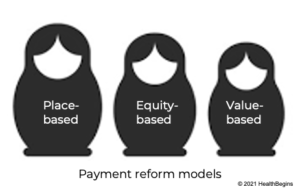Dear friends,
We’re seeing more and more health systems and payers organize around value, with value-based payment as an engine of reform. And while there’s evidence that this model can help solve some of the cost and quality problems rife in the U.S. healthcare system, challenges remain—like wildly different levels of effectiveness among value-based payment care models, difficulty in scaling models that do work, and the persistence of those that don’t. So while the shift to value is essential, it’s insufficient.
In our work with many at the forefront of trying to transform their systems to meet value-based payment models we find that a focus on value alone is not enough. For payment reform truly to be transformative, there are two more payment priorities required: place and equity.
In fact, we need to situate value-based payment models not as a solitary goal but as a related aim embedded in these two other payment reform priorities, like the smallest layer in a set of nesting dolls: first place-based, then equity-based, then value-based. 
Because in truth we can’t achieve real value if we don’t redesign—and pay for—health and social care to identify and reduce health inequity. And we can’t eliminate health inequities if local healthcare, social service, and public health institutions aren’t incentivized to align and improve the social and structural drivers of health inequity in defined places or communities.
The journey from value alone, to value and equity, is already beginning. Increasingly, people are starting to interrogate what it means to embed equity within value-based payment reforms and use those incentives to prioritize equity, particularly in quality and safety work. The next essential leap—and the next frontier in meaningful payment reform—is to situate and advance equity-oriented, value-based care within broader place-based payment reform efforts. Vanguard models like Rhode Island’s Health Equity Zones highlight a path toward greater equity and value by creating—and paying for—geographically-defined, multisector collaboratives.
Knowing about these equity and place-based frontiers of payment reform and care redesign is one thing. Navigating them is another. We’re privileged to advise, learn from, and support courageous leaders across the country to explore this new terrain in health and health care. Together we’re learning that, while traversing this next frontier can be messy and challenging, it’s also necessary and deeply meaningful.
If we can be of support as you accelerate your progress toward value-, equity-, and place-based payment reform and care redesign, please feel free to get in touch. And if you’re already well along, please reach out and let us know what you’re learning on this journey. As always, we’ll continue to do the same.
Best,

Rishi Manchanda, MD, MPH.
Featured content
Aligning Our Organizational Structure with Our Values
With our new B Corp Certification, HealthBegins has now joined a global network of companies that see business as a force for good and can share tools and practices to help us improve.
5 Principles and Practices to Sustain Gender-Affirming Care in Uncertain Times
With the onslaught of federal threats to transgender and nonbinary people, health care has a critical role to play to uphold standards of care, ensure access to essential services, advocate for evidence-based medicine, and protect patients and providers.
Strengthening Health Equity Investments with Human-Centered Stakeholder Engagement
Understanding and aligning with what value means to your stakeholders—especially those who make investment decisions—is crucial when making the business case for health equity investments.



